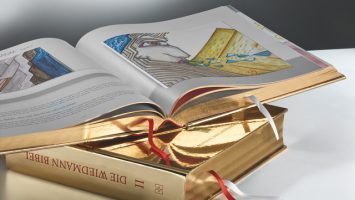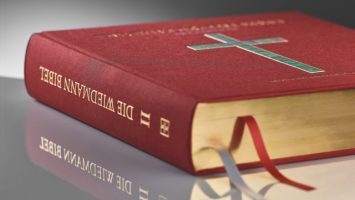An interview with Martin Wiedmann The Wiedmann Bible is an extraordinary work of art and a testament its creator’s passion and dedication. Created by Willy Wiedmann in over 16 years, the book depicts the entire Old and New Testament in 3,333 hand-painted images. In its original leporello/concertina book form, it unfolds to a total length of over 1km, revealing the truly herculean nature of the task that the artist undertook and successfully completed. However, if there is anything more impressive and extraordinary than the book itself, it is the man who created it. Endowed with a rare and multifaceted artistic talent, Willy Wiedmann was a painter, musician, composer, poet and writer, as well as a gallery owner and art dealer. He dedicated his life to art, he experimented with
Topics:
Claudio Grass considers the following as important: Thoughts
This could be interesting, too:
Claudio Grass writes The Case Against Fordism
Claudio Grass writes “Does The West Have Any Hope? What Can We All Do?”
Claudio Grass writes Predictions vs. Convictions
Claudio Grass writes Swissgrams: the natural progression of the Krugerrand in the digital age
An interview with Martin Wiedmann
The Wiedmann Bible is an extraordinary work of art and a testament its creator’s passion and dedication. Created by Willy Wiedmann in over 16 years, the book depicts the entire Old and New Testament in 3,333 hand-painted images. In its original leporello/concertina book form, it unfolds to a total length of over 1km, revealing the truly herculean nature of the task that the artist undertook and successfully completed.
However, if there is anything more impressive and extraordinary than the book itself, it is the man who created it. Endowed with a rare and multifaceted artistic talent, Willy Wiedmann was a painter, musician, composer, poet and writer, as well as a gallery owner and art dealer. He dedicated his life to art, he experimented with different styles and he even invented his own, ceaselessly creating, giving form to ideas and capturing stories through a wide variety of mediums. As for the Wiedmann Bible, the work he’s today best known for, it was never published during his lifetime.
This monumental work, might have stayed buried in the attic of his creator’s gallery, had his son, Martin Wiedmann, not uncovered it after his father’s death. Fortunately for all who love art, Martin Wiedmann decided to share this work and its story with the world. He presented it to the public in museums and exhibitions internationally, while he and his dedicated team also took painstaking efforts to digitise it and then to publish it in the form of a hardcover 2-volume book set.
To find out more about the Wiedmann Bible, its creation and its discovery, there is nobody more familiar with it to turn to than Martin Wiedmann himself. He kindly agreed to discuss the story of the book and his experiences in the interview that follows.
Claudio Grass: Let’s start by understanding a little bit more about the man behind this extraordinary work, your father, Willy Wiedmann. A born artist and a prolific one too, he spent so much of his life creating, from painting to music to poetry. How would you personally describe him as a man?
Martin Wiedmann: My father was a multi-talented artist. Art was his life. It always came first, even before his family. Without art, my father could not have existed. He painted about 30,000 paintings, composed 150 works and he was an exhibiting international artist. He also created aliases and presented his work under their names. He made them appear real, sometimes even too real, like “Emilio Graesli” for example, that had journalists believing Willy Wiedmann was actually him.
He was also very much of a character. He would not comply with what society dictated and demanded of him. If he did not like something, he would change it. For example, he did not condone the way journalists reported on art events. So he became one himself and wrote articles for the newspaper. My father was also very involved in social activities. In 2002, he received the Federal Cross of Merit for his outstanding engagement in art and culture.
He accomplished so much throughout his life. Even though we weren’t close when I was younger, I now can understand his passion and why he was the way he was.


CG: The Wiedmann Bible itself is, of course, a unique work of art. Its discovery must have been a momentous occasion, and I’m sure a memorable one too. What was your first impression and what thoughts went through your mind when you found it?
MW: I was in the process of reopening my father’s gallery in his memory. There was so much work to do. We had to declutter the whole house. When we reached the attic, we were almost done; or at least, that’s what we thought. That’s, I noticed four aluminium boxes.
When I opened the first one, I saw the leporellos. I was simply lost for words. I never expected to find such a significant and extensive artwork. Then, I found my father’s journals and an essay about his Bible, in which he explained why he painted it, why he was not able to publish his work, and what he wanted to happen with it. He wrote that he wanted to share it with the people worldwide and hoped that one day someone would find the Bible and have the time and financial means to publish it. After reading this, I was speechless. I immediately knew that I had to take on his mission and share this unique artwork with the world.
CG: Your father dedicated 16 years of his life to this work, indicating that this wasn’t a mere project, but more likely a mission he was earnestly committed to. What do think was his driving force and motivation behind all this tremendous effort, thought and planning that went into it?
Fortunately, my father wrote about this in detail in his essay about his work, so I don’t have to assume what his motivation and thoughts were. He wrote everything down and he speaks to us directly through his notes, which I think is essential to fully appreciate and understand his work, his vision and his belief in God.
Initially, he was contracted to paint murals in a church in Stuttgart Zuffenhausen. However, the council was not able to find agree on what the paintings should depict. Therefore, my father started painting in his attic. He wrote in his essay that he was driven by the desire to paint the greatest work human mankind had ever created. He also said that he had to come to terms with his past. He went to church every Sunday when he was a child, but often did not understand what the Scriptures meant. He had so many questions that he was looking forward to being able to finally answer.
In the beginning, he wrote, he had no idea what he signed up for and what it meant to translate the written Scriptures into illustrations. And yet, once he began, he simply could not stop.
CG: The whole idea of making the scriptures accessible through art means that this work transcends language, nationality and even time itself. In this sense, would you say that this work, in and of itself embodies the essence of the Christian faith, to overcome obstacles and boundaries between people?
MW: My father wrote: “Perhaps the one or the other will be able to feel God’s glory and directive through the images, or they may find consolation or admonition keeping them in their spirit. Then the artist’s work assignment would be justified.“
As you already mentioned, this work transcends language, nationalities, and time. Therefore, I am confident that it helps overcome all kinds of other obstacles and barriers too. We have experienced it already throughout our many events and exhibitions. People are curious and fascinated by it, they ask questions, strangers even start discussing the illustrations with each other. Experts have been amazed by my father’s work and confirmed that this visual narrative of the Bible is a unique treasure.
CG: The artistic and aesthetic style used in the Wiedmann Bible is very different from what most people associate with religious art or iconography. It is much more vibrant, vivid and the overall feeling it conveys is decisively positive and life-affirming. How would you classify this style and what influences do you see, if any?
MW: This type of artwork style is indeed very unique. My father created it in the ’60s and called it the “Polycon” Painting style. The term is derived from the Greek words poly- (multiple) and -ikon (picture or panel), meaning each painting was made up of multiple panels.
He incorporated in it a lot of different styles as well; such as elements of surrealism, abstract expressionism or elements of cubism. It is a composition of geometric forms (triangles, rectangles, and squares), each beginning at a 45 or 90-degree angle, that overlap, intertwine or complement each other. The different constructs create pictures within pictures, which can be perpetuated ad infinitum. My father also incorporated a musical rhythm into his art, which creates a continuous flow of this visual narrative of the Bible.
The resulting manifestation of all these patterns, combinations and overall flow, as seen in the Wiedmann Bible, is what makes it so different and so fascinating. Even the lead curator of the Museum of the Bible, Amy Van Dyke, said that the museum has never exhibited anything like this.
CG: A year ago the Wiedmann bible was published as a book for the first time. As the original Leporello format was very different, were there challenges in this process? Also, do you have further plans to bring this work to the public?
MW: The primary challenge was how to fit an almost mile-long artwork into the size of a book. Also, we were not able to retrace which Bible translations my father quoted in his notes. We needed experts to accomplish this project. I was very fortunate to get the German photographer and designer Manfred Rieker, as well as the German Bible Society, on board. Our goal was to create something of great value for mankind.
The result of our combined efforts, the ART-Edition of the Wiedmann Bible, is limited to 3,333 copies. 333 of them in gold and 3,000 in red and black. The covers are handmade and the pages have gilt edging. We have included my father’s essay in the ART-Edition. I had the honour to present the number ONE to Pope Francis in Rome in February.
A number of museums have also added the Wiedmann Bible’s ART- Edition to their inventory. Amongst them are the Gutenberg Museum in Mainz, the Bavarian State Library in Munich, the Herzogin Anna Amalia Library in Weimar, and the world’s largest Bible museum, the Bible Museum in Washington D.C. Currently, the original Wiedmann Bible is there on display. Visitors liked it so much, the museum extended the exhibition until September. Afterwards, it will be exhibited at the Dunham Bible Museum in Houston, Texas.
Claudio Grass, Hünenberg See, Switzerland
Bildrechte: ©Martin Wiedmann
